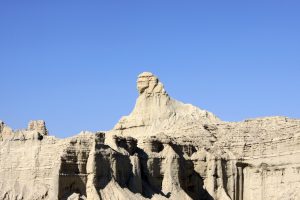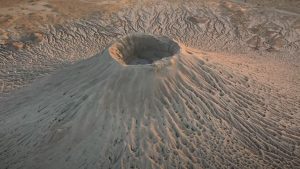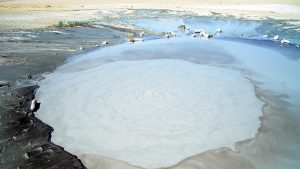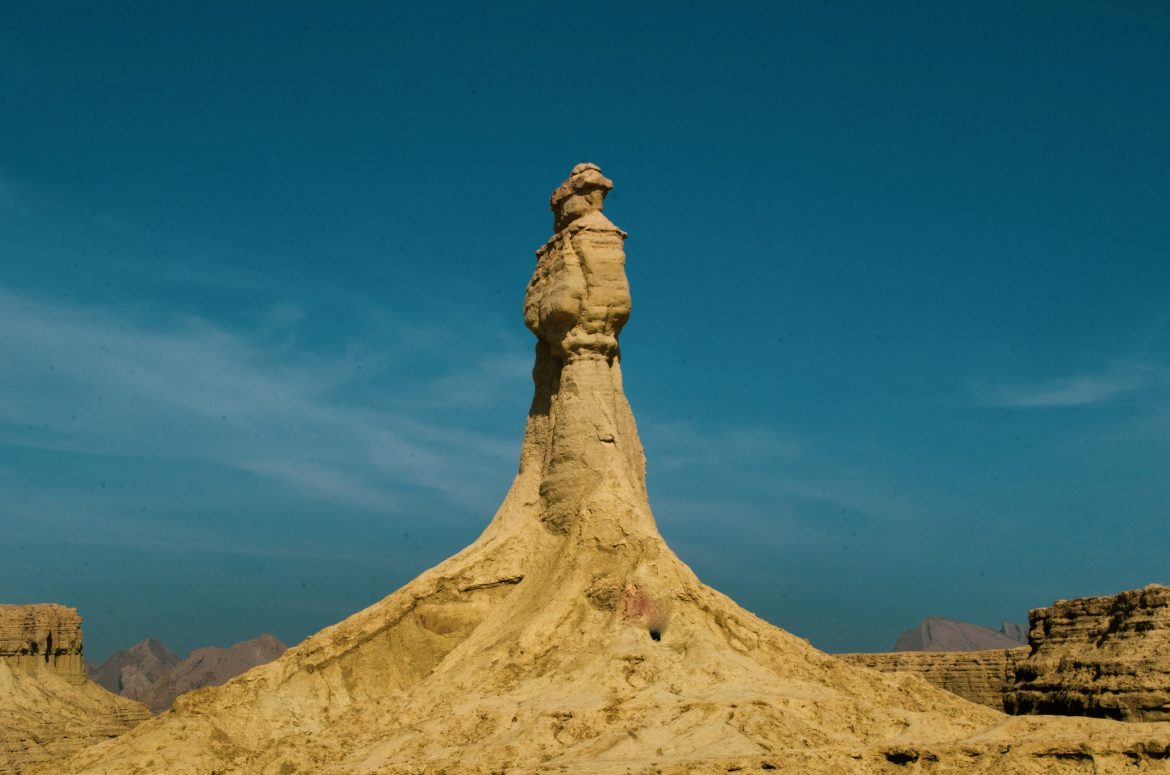The Hingol National Park is a unique and inspiring landscape with sacred significance dating back to ancient indigenous communities. This landscape, where the Princess of Hope resides, reminded me of San Padro de Atacama in Chile in many ways. For instance, both have rock formations, volcanoes, and Mars valleys.
Where is Hingol (Hungol) National Park?
Hingol (Hungol) National Park is in Lasbela, Balochistan. Lasbela means “flat plain” in the local language. The remarkable sights will surely fascinate you, so plan your trip so that when you are in Karachi, you travel to this National Park, which is 166 miles, or about a five-hour drive. It is a surreal landscape, wildlife sanctuary, and biodiversity treasure trove. This unique place was once remote and inaccessible. However, the Makran Coastal Highway completion in 2004 opened this hidden gem to tourists worldwide, inviting them to explore its unique features.
Unique Rock Formation-Princess of Hope and Sphinx
Balochistan’s renowned and fascinating rock sculptures are naturally found in the mountain range of Makran Coast. According to a joint study conducted by the University of Geneva and the University of Tehran, 36 rock formations resembling sculptures were identified in this coastal region spanning Balochistan to Iran.
Among them, two rock formations stand out. The one rock sculpture resembles a princess looking beyond the horizon and is named “Princess of Hope.” The tall and elegant statue portrays a sense of hope. Angelina Jolie visited Pakistan in 2002 as a UN Goodwill Ambassador. When she saw the rock formation, she named it “Princess of Hope” because it looked like a lady in a long dress standing in the mountain range for ages. Since then, this previously unnamed formation has become a popular tourist destination, attracting visitors from all around the world who come to witness its majestic beauty.

The Balochistan Sphinx
The second sphinx-like structure, known as the Balochistan Sphinx or the Lion of Balochistan, resembles the famous Egyptian Sphinx. Some have questioned whether it was a natural or man-made sculpture like its Egyptian counterpart, but most researchers believe it is a natural rock formation. This site underscores humans’ timeless fascination with the mysteries of the natural world and their tendency to imbue them with supernatural significance.
Mud Volcanoes

Mud Volcano

Mud volcano Chandrakup
Another crucial geological feature is the Mud volcanoes in Hingol National Park. Mud volcanoes are different from regular volcanoes as they erupt a mixture of mud and minerals in water instead of lava and are not necessarily driven by magmatic activity. These volcanoes are not extremely hot and are sometimes used for mud baths. Mud volcanoes are often found near petroleum and methane deposits.
In Purwodadi, Central Java, mud volcanoes erupt like geysers every two to three minutes. Check out the snapshot of a volcanic mud eruption in Purwodadi, Central Java, in the picture below.
There are ten clusters of mud volcanoes in Hingol National Park, but one is the most important: Baba Chandrakup. The mud mountains are about a kilometer from the Makran road, towards Gawader. This hike is quite popular among tourists and hikers. To see the crater, there are around 400 stairs to climb.
Note: Since it is generally hot and sunny, wearing sunscreen and a wide-brim hat is advisable to protect against the sun.
The Chandragup mud volcano is very significant to Hindus, who consider it an embodiment of the god Shiva. Please refer to the history section below for more information on Hindu religious rituals performed at this sacred site.
Virgin Beach
The beach Kund Malir, a corner of Hingol National Park, also known as ‘Virgin Beach,’ has earned its spot among Asia’s top 50 beaches, a list compiled by over 600 travel experts dedicated to exploring the world. The beach is a unique natural wonder where the desert meets the sea. It boasts a picturesque desert coastline adorned with palm trees. Renowned for its cleanliness and pristine, shimmering waters, Kund Malir has recently garnered widespread popularity.
Just imagine the excitement of encountering endangered species like Olive turtles and marsh crocodiles or the pure joy of observing playful dolphins in their natural environment within the national park. Marsh crocodiles are a common sight along the coastline near Hingol National Park, with an estimated population of around 60 crocodiles spread across different areas. Witnessing the migratory turtles arriving to lay their eggs along the coast in August is truly a mesmerizing sight.
Sacred Hindu Sites and Their History
This region is rich in history, dating back thousands of years to ancient civilizations such as Mehrgarh. It is also considered a precursor to the Indus Valley civilizations, including Harappa and Mohenjo-daro. The region also had significant geostrategic importance, as Alexander the Great passed through Lasbela on his way back to Babylon after conquering Northern India in 327 BC. In addition, Mohammad bin Qasim, an Arabic general of the Umayyad caliphate, entered India through this region in 715.
Before the partition, 14% of the population in the area were Hindus. As a result, these rock formations hold significant religious importance for the Hindu community. They continue to visit these places (Chandragup mud volcano and the Shri Hinglaj Mata temple) every year in April for a religious festival. The Chandragup mud volcano and the Shri Hinglaj Mata temple are located near the Hingol River in Hingol National Park and are closely associated. According to ancient traditions, pilgrims must climb the Chandragup mud volcano, also known as Baba Chandragup, before visiting the Shri Hinglaj Mata Temple. Many Hindus from Pakistan, India, and abroad visit these sites during the annual Navaratri festival.
Hindus believe that Hinglaj Mata is among the locations where the essence of Sati, the deity symbolizing marital happiness and longevity, descended to earth following her self-sacrifice.
Pilgrimage and Sacred Hindu Rituals
Pilgrims following Hindu tradition participate in a specific ritual where they stay awake throughout the night, fast, and reflect on their sins. Pilgrims present the roṭi as an homage to Baba Chandrakup as they ascend the slope of mud volcano Chandrakup. Modern practices include additional offerings like coconuts, betel nut, and dal. The offerings by fellow pilgrims, yātrīs, symbolize their devotion. At the peak of the volcano, pilgrims openly confess their sins. If there is mud bubbling, it means their sins are forgiven. Devotees throw coconuts and coins into the craters to make wishes and thank the gods for answering their prayers.
After completing the pilgrimage, pilgrims visit a temple located nearby. The temple is a natural cave-like structure without doors, and there is no artificial goddess but a natural goddess-shaped structure shaped by erosion. This rock is famous for miracles and is considered the most powerful deity. According to Hindu mythology, the temple is devoted to the goddess Hinglaj, who created the goddess Sita in Hindu mythology. This temple is one of the 52 Shakti Peethas, or goddess-centric temples. Muslims also visit this temple and take care of it.
The concept of Swayambhu in Hinduism refers to the divine presence in natural manifestations. It is a deeply rooted belief in the religious significance attached to the Hinglaj Mata valley. Therefore, the desert region and the area surrounding the Chandragup volcano are also considered part of the goddess’s sacred geography.
Another significant temple of a similar nature is Sharda Peeth, located in Azad Kashmir. It is an ancient center of learning and worship and holds immense importance in Hindu mythology and history. The temple is believed to be the abode of the goddess Saraswati and is revered by Hindus as a place of pilgrimage and spiritual enlightenment. Hence, establishing commercial activities such as shops and tea stalls in these sacred areas has been met with resistance from those who seek to maintain the sites’ religious purity and sanctity.
The conflict over these sacred places reflects broader tensions between India and Pakistan, as well as the complexities of religious identity and territorial disputes in the region. Resolving these conflicts requires delicate negotiations and a nuanced understanding of the cultural and religious sensitivities involved.

